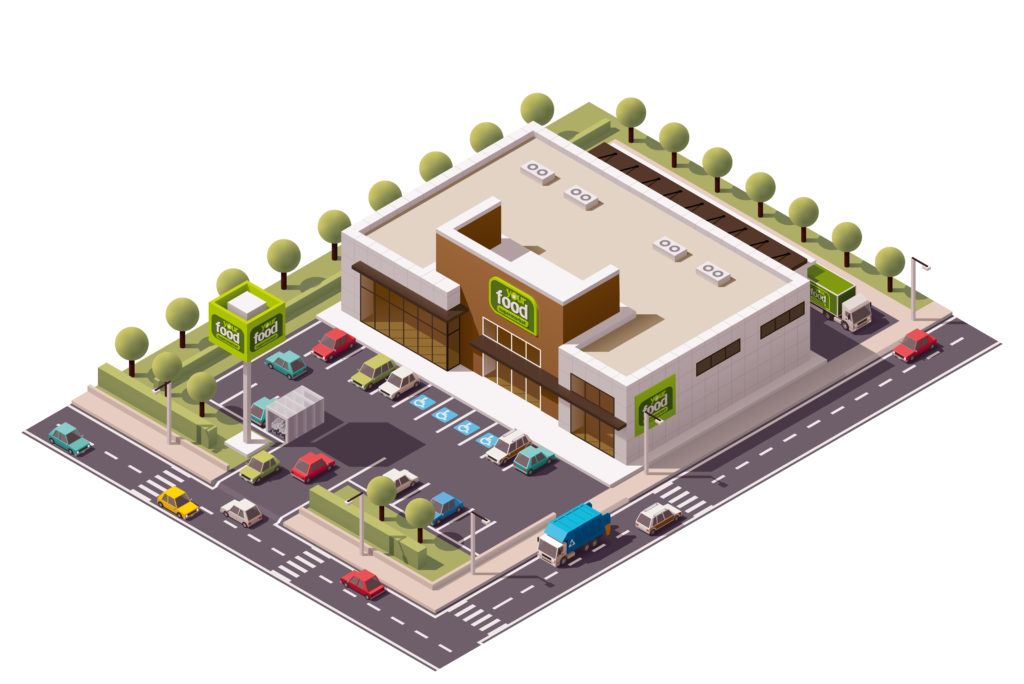
We’ve reviewed business journals, seen what direction companies are taking, and kept up with the latest developments in technology, and it’s clear that if there’s one word that defines food retail in 2018, it would be experience. It’s not only about providing an experience, but having a focused, unified experience through all of your channels. Let’s look at a few examples of stores that are providing that sort of experience.
Competitive Outlook in 2018 Food Retail
When competition between grocery stores is discussed, it usually goes the same way many people have talked about retail since the early 2000s. Many assume that online stores will dominate brick-and-mortar locations unless those physical locations launch their own e-commerce sites. While that may have been the best advice up until 2010, even 2015, the trend isn’t one versus the other. Having both options is important, which would explain why the formerly online-only Amazon is expanding into physical grocery and bookstores.
So while every year the same wisdom is repeated that grocery chains need an online presence, most stores already have e-commerce covered, and it’s not the helpful advice it once was.
It’s a pretty obvious conclusion to reach: online subscriptions for grocery deliveries might be gaining traction, but they’re not going to completely undermine an industry worth $8 trillion. Companies like InstaCart and AmazonFresh have appeal for their convenience. However, grocery stores can learn from it instead of mimicking it. Convenience is a key factor that goes beyond food being delivered to your door. It’s about prov iding a convenient experience, and several grocery chains are keeping pace by providing their own unique experience. It’s not simply about making your chain convenient. It’s about having your brand embody the experience you want to promote.
What Customers Are Looking For
Grocers in 2018 are making strides in multiple lanes, namely a preference for organic and healthy options, consciousness of price, and an emphasis on convenience.
There’s really not one specific thing that grocery customers are looking for. It’s not just the intersection of these three aspects, it’s about providing them with something unique. The best thing an analyst can do when looking at Q1 and Q2 results is to stop and think about the human element behind the numbers. Having an online store, home delivery, and cheap prices are all great on paper, but if these were the keys to success, then every other store would be following suit. While integrated infrastructure matters, it’s not a distinct draw nor a silver bullet.
Grocery shoppers have distinct and unprecedented control over where they can go to buy their food, so the goal of grocery chains should be to find creative ways to draw consumers to their location.
What brand image is your business conveying with your consumer experience?
The Difficulty in Convenience
Providing a convenient service requires the full dedication of a brand. Kroger recently delivered a letter to shareholders expressing their optimism, explaining their focus on investing in customer experience and convenience for both their shoppers and store associates. The entire Kroger brand has been built around the idea of investing in newer tech, as well as providing a seamless transition from shopping to transacting.
However, convenience is not the sole experience consumers are drawn to. When it comes to food retail, omnichannel services have seen a widespread dissemination, with nearly three-quarters of grocery stores offering multiple points of interaction with their customer.
While some of these are obviously designed for convenience, such as mobile POS, others offer more degrees of customization that make the whole process more personal. Kiosks and digital signage compatible with an IoT framework helps customers make decisions on what to purchase. Modern POS systems also provide valuable analytics that can help break down seasonal trends and preferences to better understand what customers are buying and providing more of what they want.
A One-Word Brand Experience
You can see the trend emerge: it’s not just about online options, convenience, or just having the latest tech, it’s about unifying all your channels into one cohesive brand. That means making sure your customers know your brand’s core value and figuring out why they go to your grocery locations over others.
In the past, the general wisdom has been to have a litany of core values, such as “great customer service, low price, and high-quality products.” But as discussed, that isn’t the direction that the industry is heading any longer. When you think of Kroger, you think convenience. When you think of Publix, you think organic. When you think of Aldi, you think low price. Chains are becoming more focused, and the companies that are succeeding in food retail this year are the ones emphasizing their one-word philosophy.
The takeaway: when you’re going over your quarterly report and trying to determine what steps to take next, think about how unified your brand image is and if you’re really providing the experience your customers want from your grocery chain. Find out how to unify your brand’s image through your infrastructure, and how you can use mobile devices as an opportunity for branded interaction.